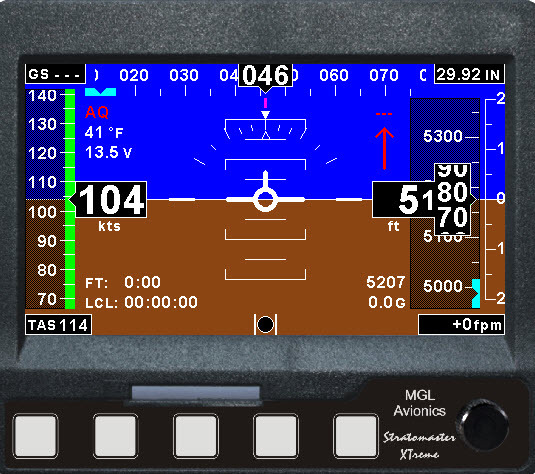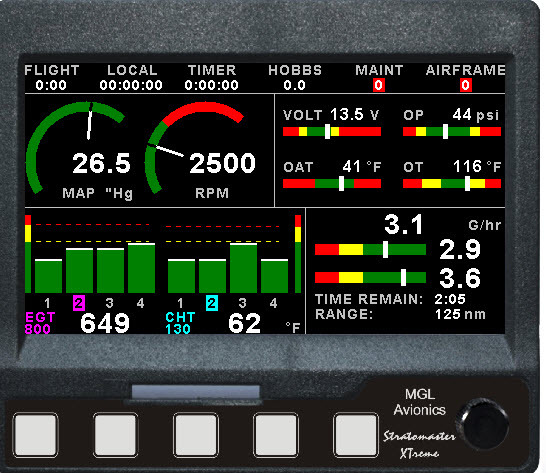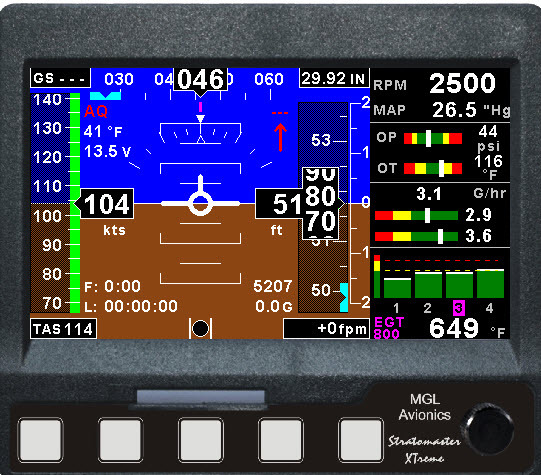Just to clarify, the MGL XTreme can be configured to be an EFIS, or EMS or a combination of both:



ortac wrote:
I can see why you would do this for the optimal sight line, but it gives the effect of the overall instrument not looking centred
With the shape it has, it will look somewhat off center no matter what you do in a single seat aircraft, but my thoughts was more about leaving enough room on the left for the other stuff. The screen is what you are looking at, so I think it is better to get that centered. But I have to see when I get all the stuff, the size of the switches and so on is very much a guess at this point.
2greens1red wrote:
with dual MGL XTreme EFIS/EMIS. We ditched the remote compass, as there was no chance of achieving accurate readings in our chrome molybdendum airframe (might have functioned with the remote sensor on the wingtip
I also thought about the Xreme a lot, but ended up with one “huge” (in relative terms) screen. The best place to put the magnetometer is far out in one wing, not much else going on at that spot. I think Garmin or GR specify to put it in the wing tip exclusively. My airplane is all aluminium/non magnetic, so I probably can put it in the tail just behind the seat somewhere up on the turtle deck.
Wing tip makes a lot of sense for the magnetometer, but, as I mentioned, strobes would make it useless.
We were too late to install it in the tail, but then you need to think about future access.
We installed it under the baggage area (under the turtle deck), but a mobile phone, or even a screwdriver, sent it wild.
So we settled for the standby compass high level, which works fine, and on the EFIS, switched heading source to track.
We’re really interested in how you get on with yours.
2greens1red wrote:
We installed it under the baggage area (under the turtle deck), but a mobile phone, or even a screwdriver, sent it wild.
Good to know. I have LED strobes in the wing tips. They should disturb much less (less current), but you never know. The outer wing panels on the Onex are foldable, and in the fold itself there are lots of iron. The only position really would then be on a rib about half way out on the outer panels, and route the wired for the lights away from it, or further aft toward the tail. Both positions would require making of some hatch. Hmm, seems I have to test and try before doing any cutting.
Did a fast google search. It seems people are happy with half way between seat and tail on top of the turtle deck and far out on the wing (MGL, Dynon or GRT). According to MGL, vibrations are also important, and this will favor the wing (or probably way back in the tail?). All RVs seem to have them in the wing tip. I think the wing tip will be my first choice.
No reason why properly wired strobes should affect the fluxgate magnetometer. Most certified planes have it like that.
A closer look over at Vans Airforce and it looks like people mount them all over the place, with varying degree of success. But no reported problems on the wing tip, strobes or not. One person even did a test with the strobe wires lying on the compass itself – no reaction on the compass. The wing tip is by far the easiest for later access also.
What affects the fluxgate is a magnetic field, and if an electric current flows there and back via two wires which are close to each other (e.g. a twisted pair) then it should cancel out. What you obviously must not do is use the airframe as a return wire, etc.
Same goes for anything else electrical on the wingtip.
That said, on my plane the strobe wires are really well routed, inside the training edge of the wing, and done with a shielded cable, but that is for radio interference reasons (the strobe inverter is often heard of peoples’ radios) rather than to cancel any residual mag field which cable shielding (copper) won’t do anyway.
How exactly should things like that be done? Ground is minus on the battery. Should there be a separate minus wire to the lights? And if shielded, should the shield be grounded, and where?
2greens1red wrote:
Wing tip makes a lot of sense for the magnetometer, but, as I mentioned, strobes would make it useless.
Why? That’s a common place for a magnetometer.
How exactly should things like that be done? Ground is minus on the battery. Should there be a separate minus wire to the lights? And if shielded, should the shield be grounded, and where?
If you don’t want to create a magnetic field, you need to achieve a zero area for the “loop” which is formed by the supply and return wires. So those two wires need to run right next to each other. So, yes, don’t use the airframe for the return as is usually done for e.g. the starter motor. Run a wire for it. Use a standard 2-core avionics cable.
You don’t need to shield a cable which carries just DC e.g. powering a lamp or an LED. The shield won’t do anything (unless there is some other, more obscure, reason for the shielding e.g. the power supply is a switching power supply and all of those radiate some RF). But wires powering strobes don’t carry DC. They carry all kinds of rapidly changing muck – even if they drive an LED “strobe light”.